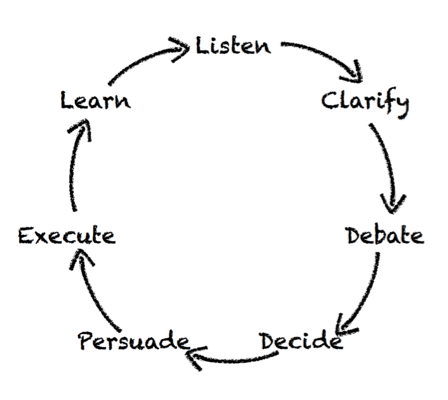LEADERSHIP LIBRARY
Radical Candor
Kim Scott
IN BRIEF
While the core of Kim Scott’s argument is that being radically candid—i.e., giving more, direct feedback—this is actually a general management book. It’s a great guide for developing relationships, helping team members develop, and leading a team that is inclusive and candid. It’s a good refresher for experienced managers and a must-read for new ones.
Key Concepts
Radical Candor, defined
Care Personally—
“The first dimension is about being more than ‘just professional.’ It’s about giving a damn, sharing more than just your work self, and encouraging everyone who reports to you to do the same.” (p. 9)
Challenge Directly—
“The second dimension involved telling people when their work isn’t good enough—and when it is; when they are not going to get that new role they wanted, or when you’re doing to hire a new boss ‘over’ them; when the results don’t justify further investment in what they’re working on.”
“And yet challenging people is often the best way to show them that you care when you’re the boss.” (p. 9)
“‘Radical Candor’ is what happens when you put ‘Care Personally’ and ‘Challenge Directly’ together.” (p. 9)
“Both dimensions of Radical Candor are sensitive to context. They get measured at the listener’s ear, not at the speaker’s mouth.” (p. 16)
“Bosses get Radically Candid guidance from their teams not merely by being open to criticism but by actively soliciting it.” (p. 34)
Getting Stuff Done Wheel
Listen—
“The keys are: 1) have a simple system for employees to use to generate ideas and voice complaints, 2) make sure that at least some of the issues raised are quickly addressed, and 3) regularly offer explanations as to why the other issues aren’t being addressed.” (p. 86)
Clarify—
“Trying to solve a problem that hasn’t been clearly defined is not likely to result in a good solution; debating a half-baked idea is likely to kill it.” (p. 89)
Debate—
“Once again, you don’t have to be in every debate—in fact, you shouldn’t be. But you’ve got to make sure that they happen, and that there is a culture of debate on your team.” (p. 93)
Persuade—
“...expecting others to execute on a decision without being persuaded that it’s the right thing to do is a recipe for terrible results.” (p. 101)
Execute—
“In order to be a good partner to the people on your team, and in order to keep the GSD wheel spinning efficiently, you need to stay connected to the actual work that is being done—not just by observing others executing but by executing yourself.” (p. 106)
Quotables
“‘This is not babysitting,’ she said. ‘It’s called management, and it’s your job!’” (p. 4)
“A good rule of thumb for any relationship is to leave three unimportant things unsaid each day.” (p. 16)
“Wanting to combat the cultural taboos against criticizing management, Toyota’s leader painted a big red square on the assembly line floor. New employees had to stand in it at the end of their first week, and they were not allowed to leave until they had criticized at least three things on the line.” (p. 35)
“In order to build a great team, you need to understand how each person’s job fits into their life goals.” (p. 43)
“It’s not about becoming a manager—plenty of individual contributors remain on a steep growth trajectory their entire careers, and plenty of managers are on a gradual growth trajectory.” (p. 49)
“Most people shift between a steep growth trajectory and a gradual growth trajectory in different phases of their lives and careers, so it’s important not to put a permanent label on people.” (p. 49)
“The essence of leadership is not getting overwhelmed by circumstances.” (p. 114)
“Don’t think of it as work-life balance, some kind of zero-sum game where anything you put into your work robs your life and anything you put into your life robs your work. Instead, think of it as work-life integration. ...Your work and your life can give each other a ‘double bounce.’” (p. 115)
“Next—and here is a slight modification if you’re talking to your boss instead of your employee—ask permission to give guidance. Say something like, ‘Would it be helpful if I told you what I thought of X?’” (p. 152)
“Criticism is a gift, and you need to give it in equal measure to your male and female direct reports.” (p. 153)
“The best advice I ever got for hiring somebody is this: is you’re not dying to hire somebody, don’t make an offer.” (p. 189)
“In some ways, becoming a boss is like getting arrested. Everything you say or do can and will be used against you.” (p. 221)



